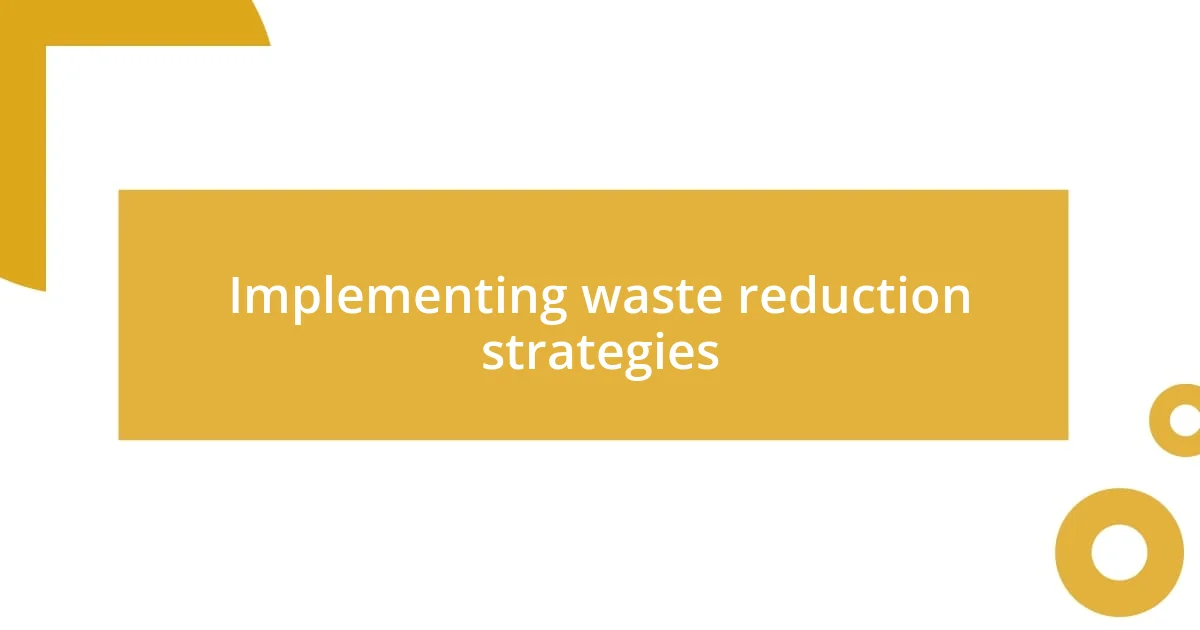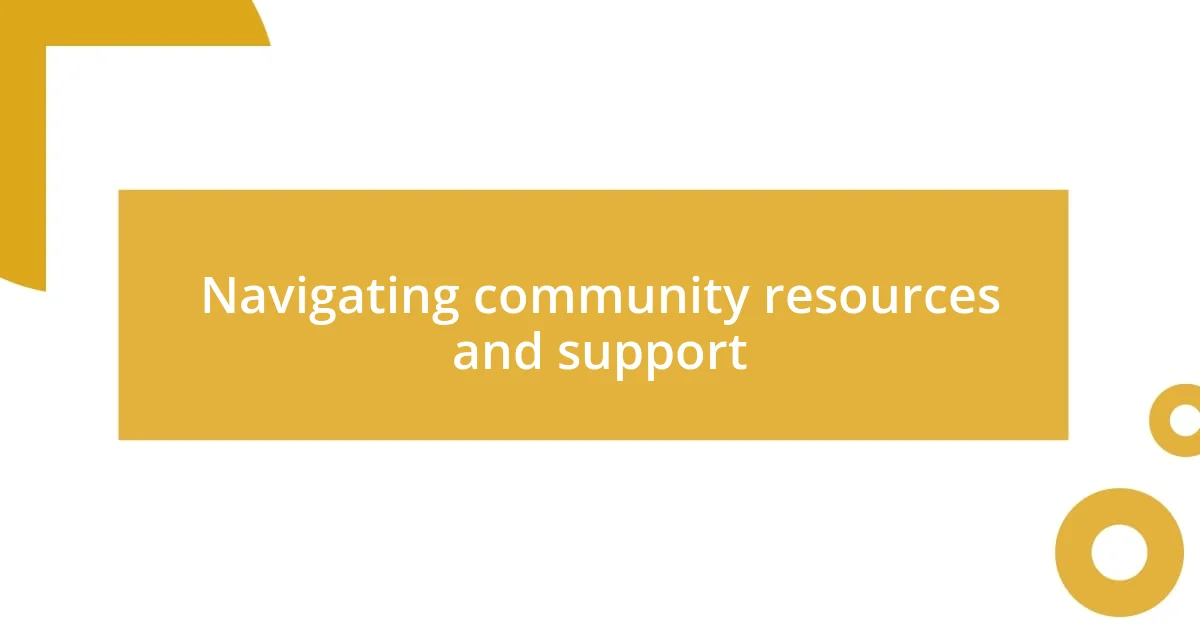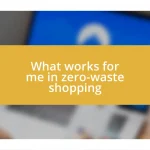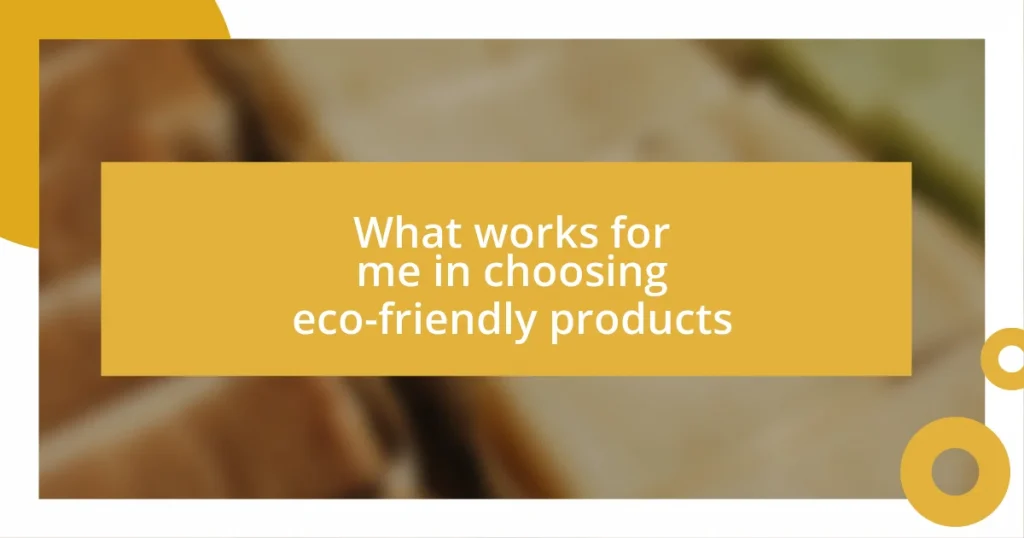Key takeaways:
- Embracing circular economy principles involves minimizing waste and maximizing resource use, fostering a mindset of sustainability and responsibility.
- Assessing consumption habits and making intentional choices, such as repurposing items and reducing impulse purchases, can significantly contribute to a more sustainable lifestyle.
- Engaging with community resources and sharing initiatives not only reduces waste but also enriches social connections and fosters collaborative sustainability efforts.

Understanding circular economy principles
Understanding circular economy principles revolves around the idea of minimizing waste and maximizing resource use. When I first learned about it, I wondered, how can I truly make a difference in my daily life? This principle encourages us to rethink our consumption patterns and be more mindful of the lifecycle of products we utilize.
The essence of a circular economy is often illustrated through the concept of “closing the loop.” Picture this: every item you own can have a second life, whether through recycling, repurposing, or sharing. I once transformed an old wooden ladder into a charming bookshelf. That feeling of extending the item’s life and purpose was rewarding, and it sparked a deeper curiosity in me—what else could I revive?
Moreover, embracing circularity also means building a mindset of sustainability. I’ve found that it pushes us to consider the environmental impact of our choices, asking ourselves questions like, “Where does this product go after I use it?” This shift in thinking not only changes how we interact with products but also fosters a sense of responsibility toward our planet.

Assessing my consumption habits
When I took a hard look at my consumption habits, I was surprised by how many items I bought without thinking about their long-term impact. It wasn’t just about the money spent; it was about the resources that went into making these products. I started journaling my purchases, and noted how often I felt compelled to get the latest gadget or trendy clothing. This simple act of self-reflection opened my eyes to patterns I hadn’t noticed before.
It struck me how frequently I tossed away items that could have been repurposed. For example, instead of throwing out a pair of jeans with a small tear, I decided to upcycle them into a stylish tote bag. This not only extended the life of the fabric but also gave me a unique accessory that drew compliments. Each small victory contributed to my growing commitment to a circular economy lifestyle.
Another key insight was the importance of asking myself, “Do I really need this?” I embraced a more intentional approach to shopping, where I’d pause and evaluate my true needs versus wants. Through this shift, I found not only a reduction in clutter at home but also a deeper satisfaction in what I chose to keep. It was surprisingly liberating to simplify my life and trust that less really can be more.
| Consumption Habit | Old Approach | New Approach |
|---|---|---|
| Impulse Purchases | Frequent & Unplanned | Mindfully Considered |
| Waste Disposal | Regularly Tossed Items | Repurposed or Recycled |
| Shopping Motivation | Trends & Fads | Needs & Sustainability |

Identifying sustainable alternatives
Finding sustainable alternatives became a vital part of my transition to a circular economy lifestyle. I realized that every choice I made—every product I purchased—could either contribute to waste or foster sustainability. For instance, I switched to using reusable produce bags for grocery shopping instead of those flimsy plastic ones. It was such a small change, yet it felt empowering to eliminate plastic with each trip. This led me to explore other alternatives that aligned with my newfound principles.
Here’s a quick breakdown of some sustainable alternatives I identified:
- Reusable containers to minimize single-use plastics.
- Second-hand shops for clothing and furniture instead of new purchases.
- Local farmers’ markets for fresh produce, reducing my carbon footprint.
- DIY cleaning products made from vinegar and baking soda, eliminating harsh chemicals.
- Digital subscriptions for books and magazines, reducing paper waste.
Each of these changes felt like a personal victory, reinforcing my commitment to a more sustainable lifestyle. It became clear that even simple shifts not only lightened my ecological footprint but also infused joy into my everyday routines.

Implementing waste reduction strategies
Adopting waste reduction strategies isn’t always straightforward, but I found that starting small can lead to significant changes. One of the first tactics I employed was focusing on my food waste. By meticulously planning my meals and using every bit of my ingredients, I felt a sense of accomplishment with each well-prepared dish. Have you ever realized how much impact a little pre-planning can have? It minimizes that guilt of throwing away leftovers while making my grocery trips more intentional.
Another effective strategy was committing to a zero-waste challenge for a month. This experience pushed me to scrutinize what I bought and how I disposed of it. I remember feeling like a detective in my own home, searching for ways to eliminate plastic packaging and other non-recyclable items. It opened my eyes to alternatives I had never considered before. For example, I switched to bar soap and shampoo bars, which not only cut down on plastic but also added a lovely scent to my bathroom!
Ultimately, I realized that change doesn’t happen overnight; it’s about creating new habits that reflect my values. I started crafting a waste diary where I noted what I tossed out each week. Surprisingly, seeing those numbers helped me identify patterns and make adjustments. What struck me was how empowered I felt as I witnessed my waste diminish. It’s like watching your garden flourish after nurturing it, and every bit of reduction felt like a step toward a brighter, cleaner future.

Embracing sharing and swapping
Engaging in sharing and swapping has transformed my approach to consumption. I remember the first time I attended a clothing swap with friends; it was like a treasure hunt in someone else’s closet. I found a beautiful jacket that I absolutely loved but would have otherwise overlooked in a store. Swapping not only feels like a money-saver but also reduces the demand for brand-new items, which is a win-win in my book.
Sometimes I think about how much time we often spend decluttering our spaces, only to buy new things we don’t truly need. When I embraced the idea of sharing, it became a game changer. Instead of letting tools gather dust, I joined a local tool library. It was a small leap to ask to borrow a drill for a weekend project, but it sparked a sense of community and connection that I hadn’t anticipated. Picture this: rather than investing in a costly gadget that I would use once or twice, I got to know my neighbors and share stories while lending a helping hand or receiving one in return.
I’ve learned that sharing and swapping isn’t just about material goods; it’s about building relationships and fostering sustainability. I often think about the last time I borrowed my neighbor’s lawnmower. That simple act cultivated a sense of camaraderie and reinforced my commitment to a circular economy lifestyle. Have you ever noticed how these moments create a ripple effect in your community? It’s fulfilling to realize that by choosing to share, we can diminish waste while simultaneously enriching our social connections.

Tracking my environmental impact
Tracking my environmental impact has become a vital part of my journey. I started using a simple app to record my daily habits, like how much water I consumed and where my food came from. At first, I thought it would be a tedious task, but I quickly discovered it was eye-opening! Seeing the data helped me understand my habits better and identify areas for improvement. Have you ever seen how just a few changes can make a big difference?
One memorable moment was when I analyzed my transportation choices. I realized that I was relying too heavily on my car. So, I challenged myself to walk or bike whenever possible. The transformation was incredible! Not only did I enjoy the fresh air, but I also felt energizing a sense of freedom with every step or pedal. Tracking my miles saved became a bit of a game; it pushed me to seek alternative routes and take the scenic path, quite literally.
Sometimes, I find tracking environmental impact doesn’t just reflect numbers; it’s a personal journey filled with victories and setbacks. For instance, I remember feeling proud of drastically reducing my plastic consumption, only to slip up one week and forget my reusable bags. Instead of beating myself up, I noted it in my tracker, which reminded me of my commitment. This embrace of real-time reflection has taught me that measuring my impact is just as much about acknowledging the process as it is about the numbers. How do you measure your progress on your eco-journey?

Navigating community resources and support
Community resources have played a crucial role in my adaptation to a circular economy lifestyle. When I first ventured into my local co-op, I was surprised by the wealth of knowledge and support available. The workshops on composting and upcycling were not just educational; they created a space where I could connect with like-minded individuals who shared my sustainability goals. Have you ever walked into a place where the atmosphere buzzes with shared purpose? It’s invigorating!
I also discovered how valuable online community groups can be. Platforms like Facebook and Nextdoor make it easy to share resources, ask questions, and even organize local clean-up events. I vividly recall posting about my quest for second-hand furniture and was flooded with recommendations. It felt great knowing that my community was willing to help, reminding me that sustainability is often a team effort. Have you found communities that support your eco-friendly endeavors?
Another highlight was attending a community swap meet, where neighbors traded everything from home decor to seeds for gardening. I remember leaving with not just items, but a deeper connection to those around me. Each interaction felt meaningful—like little victories in our collective commitment to reducing waste. In what ways have you engaged with your community to support sustainable living? Sometimes, it’s the smallest gestures that have the biggest impact.















